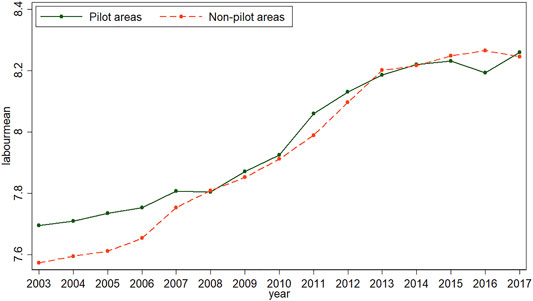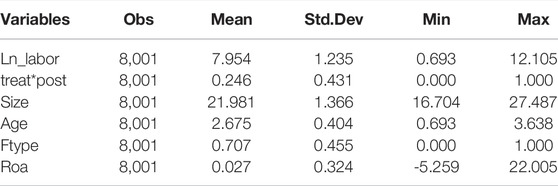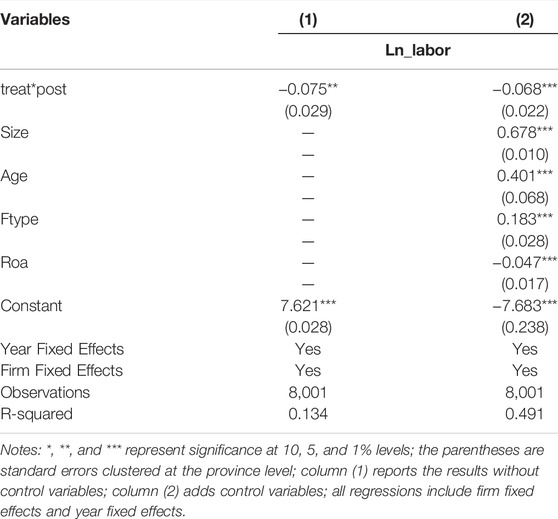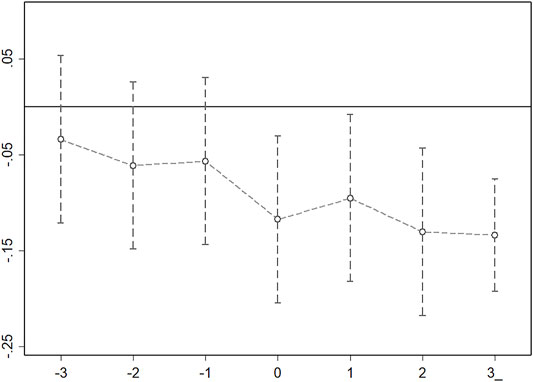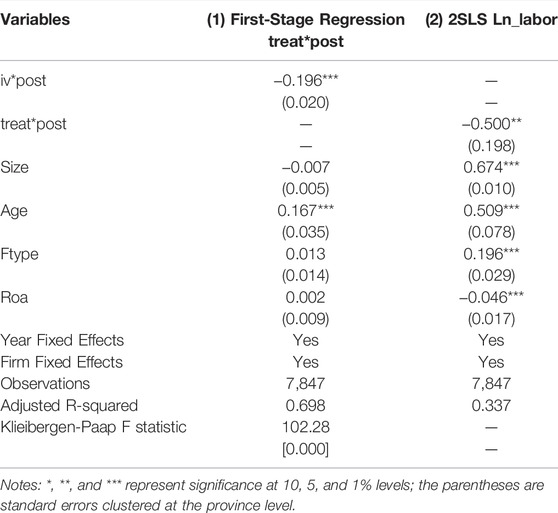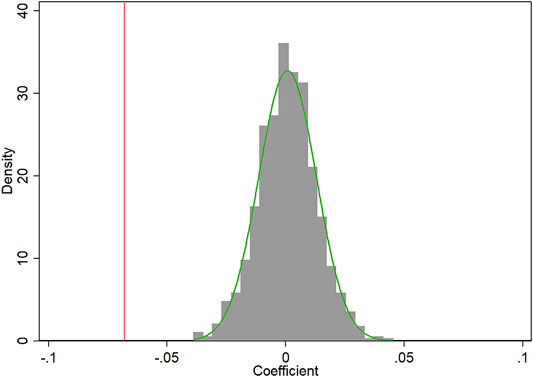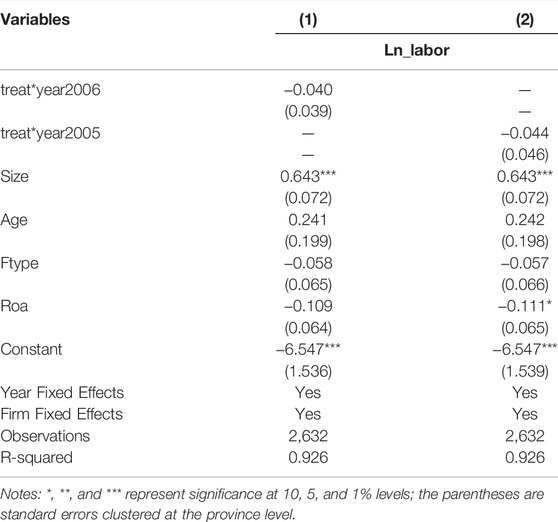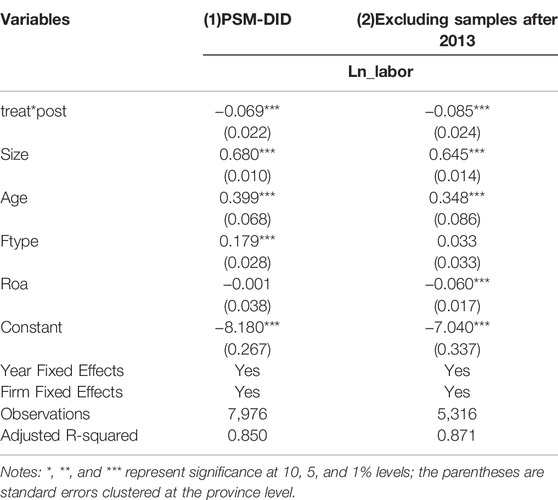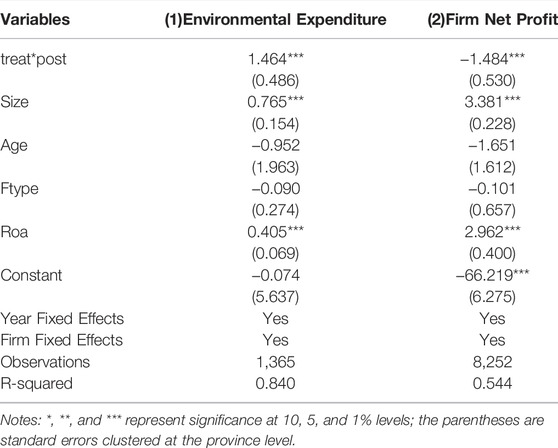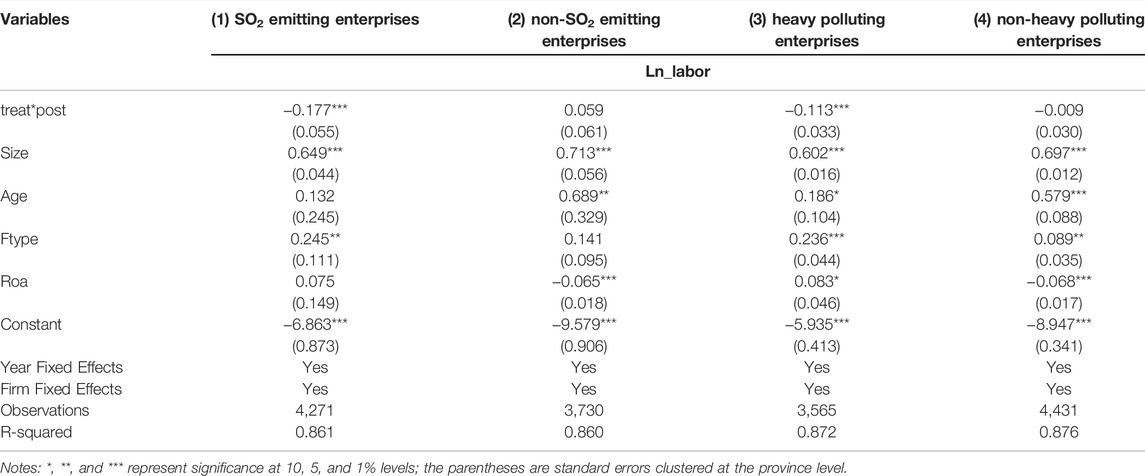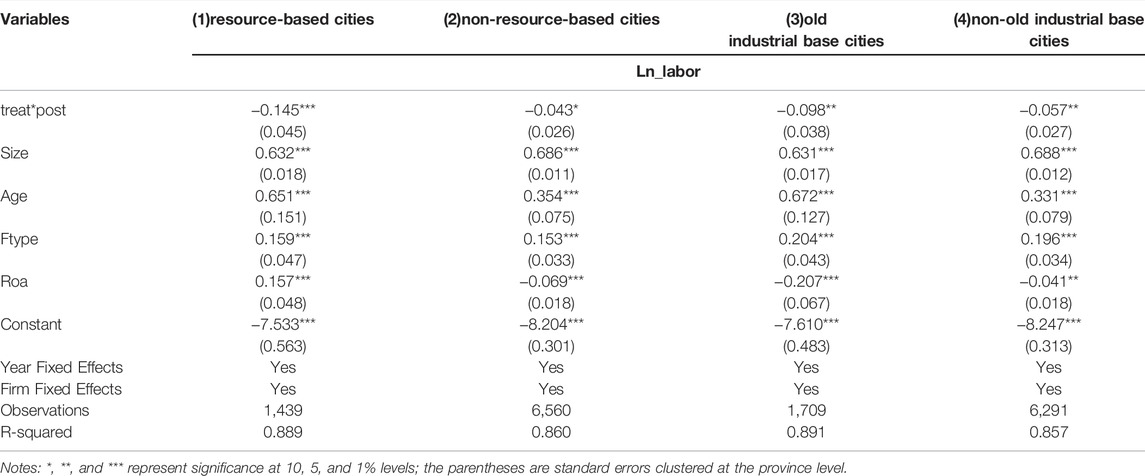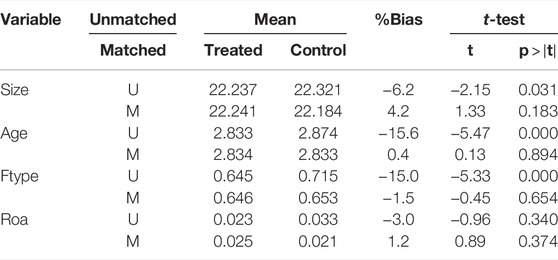- 1Research Institute of Economics and Management, Southwestern University of Finance and Economics, Chengdu, China
- 2School of Business, Beijing Institute of Fashion and Technology, Beijing, China
- 3School of Business, Stevens Institute of Technology, Hoboken, NJ, United States
The emissions trading program (ETP) is an effective means to fight environmental pollution. However, it may also spur the increase of enterprise costs, which affects employment and economic development. Adopting a difference-in-differences method and exploiting China’s emissions trading policy in 2007 as a quasi-natural experiment, we investigate the impact of the ETP on firms’ labor demand and the mechanism facilitating this effect. The results show that the ETP significantly reduces firms’ labor demand. The conclusion remains robust after using an instrumental variable to alleviate the possible endogeneity problem. Mechanism analysis indicates that the ETP reduces firms’ labor demand via increasing firms’ environmental expenditure and reducing profits. The heterogeneity analysis shows that the ETP significantly reduces the labor demand of SO2 emitting firms and heavy polluting firms, while having no significant impact on the labor demand of non-SO2 emitting firms and non-heavy polluting firms. This negative impact is more prominent for resource-based cities and old industrial base cities. This paper provides empirical evidence and policy implications for implementing the ETP in developing countries.
1 Introduction
Since the reform and opening up, relying on the development strategy of heavy industry first, China has achieved rapid economic growth (Cai, 2013). However, this growth has been achieved at the expense of the environment. The environmental damage is due to heavy resource consumption (energy, fossil fuels) in industrial development (Hao et al., 2015). In this case, environmental problems have been rapidly magnified along with this development (Shahzad et al., 2021; Shahzad et al., 2022). Environmental pollution seriously affects the government’s image and hinders the high-quality development of China’s economy (Chen and Chen, 2018; Hao et al., 2018; Feng et al., 2021), which has become an urgent problem in China (Guo et al., 2021). The ETP is a common means for governments in various countries to deal with environmental issues (Calel and Dechezleprêtre, 2016; Zang et al., 2020). For instance, the United States implemented the cap-and-trade program for sulfur dioxide in 1990, and the European Union established the European Union Emission Trading Scheme (EU ETS) in 2005, which is the world’s largest cap-and-trade system for carbon dioxide emissions. In 2007, China began to implement a pilot policy on the paid use and trading of emission rights, covering a wide range of pollutants, including sulfur dioxide, nitrogen oxides, and other pollutants. Proponents of environmental regulations argue that environmental regulations will reduce pollutant emissions and bring health benefits to society. Opponents believe that this system will impose huge costs on enterprises, which will result in an increasing unemployment rate and harm economic development (David et al., 2013; Curtis, 2018). As an important means of environmental regulations, how the ETP will affect the local labor market attracts academic and political attention.
Unlike the previous command-and-control policies, the ETP is based on market-based regulations that adopt controlling total volume and trading methods to govern the environment. Its core idea is to set a maximum amount of pollution in a region and assign the right to discharge to each enterprise (Ji et al., 2017; Schmalensee and Stavins, 2017). Emission rights are bought and sold among enterprises in a monetary exchange. Generally, heavy polluters are the buyers of emission rights. They need to pay high fees to obtain emission rights, which means polluting enterprises are mainly responsible for pollution control (Shi and Li, 2020). By transforming the cost of pollution control from social cost to private cost, the ETP changes pollution control from compulsory government action to a conscious market action by enterprises, which has become an essential means for China to control pollution and protect the environment (Huang J. et al., 2021). So how will the emissions trading policy affect the labor demand of Chinese enterprises, especially the heavy polluters?
Upon reviewing previous literature, there is no consensus conclusion on the impact of the ETP on firm employment. Anger and Oberndorfer (2008) examine the impact of the EU ETS on the income and employment of 419 German enterprises. They find that the policy did not significantly impact employment at regulated firms in Germany. Similarly, Chan et al. (2013) use the EU ETS to study the impact of the scheme on the labor demand of firms in the electricity, cement, and steel industries in 10 European countries from 2001 to 2009, and reach the similar conclusion that the policy has no significant impact on firms’ employment in these industries. Based on data on 526 fossil fuel-fired power plants in the United States from 1998 to 1999, Ferris et al. (2014) take the impact of the SO2 emissions cap-and-trade program implemented in 1990 as an exogenous shock to firm employment. They find that the policy has no significant effect on the labor demand of power enterprises in the United States. However, Curtis (2018) uses U.S. state-industry and county-industry data from 1998 to 2009 to study the impact of the U.S. NOx trading program on employment. Results show that the ETP reduces the number of manufacturing jobs by 1.3% and employment in energy-intensive industries by 4.8%. Ren et al. (2020a) explore the impact of the SO2 ETP on firm employment by using data from China’s mining and manufacturing firms from 2004 to 2016. They find that the ETP has raised the labor demand of these firms. The first reason for the different conclusions in the literature is that they use various ETPs of different countries, such as Europe, the United States, and China, which differ significantly in national systems and economic development. Second, the inconsistent results may be due to the differences in the types of trading rights and industries. Furthermore, the above-mentioned literature mainly focuses on developed countries, such as Europe and the United States, while research on developing countries is limited. Moreover, extant studies ignored that the emissions trading pilot regions selected are not random, but are usually a self-selection process determined by economic development, pollution level, and environmental regulations in various provinces and cities (Wang et al., 2019; Huang J. et al., 2021). This “selection bias” would lead to the “endogeneity problem".
Based on the above background and existing research, exploiting the 2007 China emissions trading pilot policy as a quasi-natural experiment, using data from listed firms from 2003 to 2017, and employing a difference-in-differences (DID) method, we explore the impact of the ETP on firms’ labor demand and its mechanisms. The results show that the ETP reduces labor demand in regulated enterprises. Mechanism analysis reveals that the ETP significantly increases firms’ environmental expenditure (firm costs), and reduces profits, leading to the decline of firms’ labor demand. To alleviate endogeneity issues stemming from the non-random implementation of ETP, we adopt the ventilation coefficient as an instrumental variable and find the results remain robust. The heterogeneity analysis indicates that the ETP significantly reduces labor demand in SO2 emitting firms and heavy polluting firms, while having no significant impact on labor demand in non-SO2 emitting firms and non-heavy polluting firms. This negative impact is more pronounced for resource-based cities and old industrial base cities.
This paper mainly has two contributions: first, it is a valuable complement to the literature related to the impact of ETP on labor demand. The existing literature mainly focuses on developed countries, such as the United States and Europe, while research on developing countries is rare. The most relevant literature is Ren et al. (2020a), who focus on the effect of SO2 ETP on employment in firms in two industries, manufacturing, and mining. In fact, China’s 2007 ETP includes trading multiple pollutants, such as SO2, NOX, COD, and ammonia nitrogen. Therefore, this paper evaluates the comprehensive effects of this emissions trading policy on firms’ labor demand. Moreover, by constructing the instrumental variable, we identify the causal effect of the ETP on firms’ labor demand. Second, this paper enriches the existing literature on how ETP affects firms’ labor demand. Existing literature exploring the mechanism from a firm’s cost-benefit perspective is scarce. From the perspective of environmental regulation affecting firms’ costs, we verify that China’s ETP affects labor demand via firms’ environmental expenditure.
The remainder of the paper is structured as follows: the second section is the institutional background and empirical strategy; the third section is the empirical analysis; the fourth section is the robustness checks; the fifth section is mechanism analysis; the sixth section is the heterogeneity analysis, and last part is conclusions and policy implications.
2 Institutional Background and Empirical Strategy
2.1 China’s Emissions Trading Policy
The exploration of China’s emissions trading policy dates back to 2002. The former Ministry of Environmental Protection of the People’s Republic of China (MEP) implemented the “4 + 3+1” sulfur dioxide emissions trading pilot policy, which was implemented in four provinces, including Shanxi, Shandong, Henan, and Jiangsu, three cities, including Tianjin, Shanghai and Liuzhou, and China HUANENG GROUP Corporation1. The early pilot was mainly limited to the power sector in some cities (Chang and Wang, 2010). In fact, the trading volume in these pilot areas was almost zero as no emissions trading center was established (Huang J. et al., 2021). Chinese scholars also find that the 2002 pilot policy did not achieve significant results (Qi et al., 2018). In 2007, the Ministry of Finance and the MEP, and the National Development and Reform Commission further expanded pilot areas and carried out this project in 11 provinces, including Hebei, Tianjin, Inner Mongolia, Henan, Jiangsu, Hubei, Zhejiang, Shanxi, Chongqing, Hunan, and Shaanxi. On 10 November 2007, China’s first emissions trading center was officially inaugurated in Jiaxing City, Zhejiang Province, marking the institutionalization, standardization, and internationalization of China’s ETP. Other pilot regions have subsequently set up emissions trading centers and completed emissions trading markets. With the promotion of the pilot policy, the types of pollutants traded and the trading volume has gradually increased (Ren et al., 2020b). By 2018, the cumulative amount of emission rights fees paid in the primary market reached 11.77 billion yuan, and the accumulated transaction in the secondary market reached 7.23 billion yuan.2 Scholars have widely recognized 2007 policy for its effective treatment in curbing environmental pollution in China (Wu et al., 2019; Ren et al., 2020b; Huang J. et al., 2021). Therefore, this paper explores the impact of the 2007 expanded pilot ETP on firms’ labor demand.
2.2 Data and Variable Description
We take listed enterprises in 31 provinces of China from 2003 to 2017 as the research sample. Referring to Du et al. (2014) and Ren et al. (2020a), we processed the list enterprises data as follows: first, we deleted special treatment (ST) and *ST enterprises as these firms have undergone losses for two or three consecutive years; second, we excluded the enterprises with relatively serious missing values. The financial data of listed enterprises were obtained from the China Stock Market and Accounting Research database (CSMAR). The labor force data of the enterprises is derived from the WIND database (Wind).
The dependent variable is the labor demand of enterprises, measured by the natural logarithm of the number of listed enterprises’ employees. The core explanatory variable is a dummy variable indicating whether a province has implemented the ETP. If a listed enterprise is located in any pilot region, the value is 1 after the 2007 years; otherwise, the value is 0.
Based on the ETP pilot and non-pilot areas, we calculated the average number of firms’ employees and displayed their trends in Figure 1. By comparing the changing trends of the treatment and control groups, we can directly observe the impact of the ETP on the labor demand of enterprises. From 2003 to 2017, the labor demand of the two groups generally showed an upward trend. Before 2012, the labor demand in pilot regions was higher than that in non-pilot ones. Figure 1 shows that before implementing the pilot policy in 2007, the trends of firms’ labor demand in the pilot and non-pilot regions were basically parallel. Since 2008, the gap between the two significantly narrowed. Moreover, the labor demand of the pilot and non-pilot regions both kept growing between 2008 and 2012. Finally, in 2013, the labor demand of the non-pilot regions exceeded that of the pilot ones. Therefore, we believe that the decrease in labor demand in the pilot areas relative to the non-pilot ones may be caused by the ETP introduced in 2007.
Referring to Li et al. (2016) and Liu et al. (2021), we selected control variables that include enterprise size (Size), enterprise age (Age), enterprise nature (Ftype), and return on assets (Roa). Among them, enterprise size is the natural logarithm of the enterprise’s total assets at the end of the year; enterprise age is calculated using current year minus the year enterprise opened plus one; Return on assets is the ratio of the firm’s operating profit to total assets at the end of the year. Enterprise nature is a dummy variable. If the firm’s ownership is state-owned, the value is one; otherwise, the value is 0. The descriptive statistics of each variable are shown in Table 1.
2.3 Identification Strategies
This paper aims to explore how the implementation of ETP affects firms’ labor demand. Considering the implementation of ETP and firms’ labor demand may simultaneously be affected by some unobserved factors, making it difficult to draw the causal inference. Therefore, we adopt the panel DID approach3 as our main regression model to address the omitted variable problem. Drawing on Ren et al. (2020b) and Moser and Voena (2012), we set the model as follows:
where
This DID estimation compares one firm’s labor demand performance before and after implementing the ETP (the first difference) with the changes among non-ETP counterparts during the same period (the second difference). The single difference method is usually referred to either the first difference or the second difference in Eq. 2. Compared with the single difference method, DID model has a control group, which can eliminate the estimation bias that may be caused by common shocks and time trends during the same period and obtain more accurate results. If the coefficient
The validity of the DID model relies on the “common trend” assumption, i.e., changes in firms’ labor demand in the treatment group (ETP firms) and the control group (non-ETP firms) should show similar time trends before the implementation of the ETP. Although it can be seen from Figure 1 that the labor force of listed firms in the pilot and non-pilot provinces are parallel before this policy, this assumption can be rigorously tested via using the event study method. Drawing on Jacobson et al. (1993), Beck et al. (2010), and Zhou et al. (2020), we set the following specification:
where
3 Empirical Analysis
3.1 Baseline Results
To evaluate the policy effect of implementing the ETP on firms’ labor demand, we construct a firm-year panel data structure. Table 2 presents the main results of model (1). Column 1) shows the estimated results with year fixed effects and firm fixed effects. The results indicate that firms’ labor demand in the ETP pilot regions decreases by 7.5% on average compared to that in the non-pilot regions. Column 2) additionally adds the firm-level control variables based on column (1), and the regression results remain basically unchanged with an estimated coefficient of -6.8%. This finding suggests that China’s pilot emissions trading policy did reduce firms’ labor demand. The negative result is consistent with that of Curtis (2018).
3.2 Parallel Trend Test
The most important prerequisite for the DID approach is that the treatment group has a common trend with the control group. Eq. 3 is used to test for similar time trends in labor demand between ETP firms and non-ETP firms before the ETP implementation. Figure 2 displays the estimation coefficients and 95% confidence intervals. The results reveal that the coefficients of
3.3 Instrumental Variable Estimation
Although we use DID method to identify the net effect of the ETP, the endogeneity problem may arise because the selection of ETP pilot regions is not random, which may be influenced by some potential factors that may interfere with the estimation results of DID model. Therefore, this paper further constructs an instrumental variable to alleviate such potential endogeneity. Theoretically, the appropriate instrumental variable needs to satisfy two conditions. First, instrumental variables are closely correlated with endogenous variables; second, exclusive conditions. That is, instrumental variables are uncorrelated with the error term. Drawing on the practice of Hering and Poncet (2014) and Shi and Li (2020), we adopt the ventilation coefficient as an instrumental variable for the implementation of the ETP in the pilot province at time t. The ventilation coefficient is considered the determinant of air pollutants’ dispersion speed (Jacobsen, 2002; Broner et al., 2012). It is defined as the product of wind speed and boundary layer height, determining the horizontal dispersion of pollutants and the height at which pollutants disperse in the atmosphere4. Areas with a higher ventilation coefficient suffer less from air pollution, so these locations are less likely to become the emissions trading pilot regions. Moreover, the ventilation coefficient is determined by large-scale weather systems, which are considered as an exogenous shock to local economic activity.
Table 3 shows the estimated results of the instrumental variable. Column 1) reports the first-stage regression results, the coefficient of iv*post is negatively correlated with the endogenous variable, and F statistic is far greater than 10, rejecting the hypothesis of the weak instrumental variable; Column 2) shows the second-stage regression results, which is consistent with the baseline regression. This result indicates that after eliminating the endogeneity problem, the ETP still significantly reduces the firm’s employment.
3.4 Robustness Checks
3.4.1 Placebo Test
To exclude that the estimated effects are randomly generated and to ensure that the ETP brings about the findings, we conduct a placebo test by randomly assigning pilot provinces (Cai et al., 2016; Cantoni et al., 2017). Specifically, we performed 1,000 sampling in 31 provinces in China, and 11 provinces were randomly selected as the virtual treatment group and the remaining 20 provinces as the control group in each sampling. The estimated coefficients of “virtual ETP provinces” were recorded and the results are shown in Figure 3. The results show that the regression coefficients of these virtual treatment groups obey a normal distribution with a mean of zero, which means virtual ETP policies have no significant impact on firms’ labor demand. Moreover, the estimated coefficient of the actual ETP is shown as a vertical line, located at the far left (-0.068). These results suggest that the decline of firms’ labor demand is driven by the implementation of the ETP, not caused by other policies.
3.4.2 Counterfactual Test
The validity of using DID model is that the treatment and control groups are comparable, i.e., without the ETP, the growth rate of firms’ labor force in both groups should keep in sync. To verify this assumption, referring to Hung et al. (2013) and Shi and Li (2020), we advanced the implementation time of the ETP and constructed a series of virtual ETP policies. Specifically, we retain only samples before 2007 and assume that the ETP was implemented in 2005 and 2006. Table 4 displays the estimated results of the counterfactual test. It shows the virtual ETP is not significant, which indicates that bringing forward the actual implementation time of the ETP did not have a significant effect on firms’ labor demand. It implies that the actual ETP did reduce firms’ employment in the pilot area.
3.4.3 PSM-DID Estimation
To verify the robustness of the conclusions, we use the PSM-DID method to alleviate potential bias caused by sample selection. The idea is to select a control group with similar individual characteristics before the policy for each treatment group.5 Then, keep all the successfully matched firms as the PSM-DID regression samples. Therefore, after ruling out this interference, the PSM-DID estimated results reported in Table 5 show that the ETP still significantly reduces firms’ labor demand.
3.4.4 Eliminating the Interference of Other Policies
In 2013, The State Council approved the “Plan for The Adjustment and Transformation of National Old Industrial Bases (2013–2022)" and “Plan for the Sustainable Development of National Resource-based Cities (2013–2020)". Previous studies have shown that compared with non-resource-based cities, resource-based cities have higher resource dependence and face drastic industrial structure transformation pressure. Implementing environmental regulations in these areas may bring further social problems such as unemployment and re-employment (Li and Zhou, 2018). These adjustments are also carried out in the old industrial base, which may bring similar employment problems. To accurately identify the net effect of the ETP, it is necessary to eliminate the interference from other similar policies at the same period. Therefore, we exclude the data from 2013 to 2017. The regression results are shown in Column 2) of Table 5. The estimated coefficient is still significant, which indicates that the conclusion is robust.
4 Mechanism Analysis
Baseline results and robustness tests confirm that the ETP impedes firms’ labor demand. Therefore, a question on how this policy affects firms’ labor demand arises. Theoretically, according to the “Porter Hypothesis”, environmental regulation will change production processes while regulation compliance will increase production costs (Sadik-Zada and Ferrari, 2020; Wang et al., 2021). Therefore, ETP, as an important means of environmental regulation, may increase the environmental costs of firms in the pilot areas. The increase in firms’ costs will both reduce their profits and affect reinvestment, which leads to a decline in their labor demand (Lewis, 1954; Sadik-Zada, 2021).
To test the above mechanism, we manually collected the annual reports disclosed by listed enterprises each year and compiled their annual environmental expenditure according to the report contents. Since not every enterprise published environmental expenditure, we finally got 1,365 samples that matched our data. Column 1) of Table 6 reports the impact of the ETP on firms’ environmental expenditure, which reveals that the ETP indeed increases firms’ environmental expenditure. This finding is consistent with that of Bashir et al. (2021), who similarly verifies that environmental regulation increases environmental expenditure. Therefore, the ETP is effectively verified to affect the firm’s labor demand via environmental expenditure.
Given the limited data collected on environmental expenditure, the credibility of the results may be compromised. To further confirm the above speculations, we directly examine the impact of the ETP on firms’ net profits. The reason for using firms’ net profits is that the increase in environmental expenditure (firms’ input cost) reduces firms’ net profits. Column 2) of Table 6 reports the ETP reduces firms’ net profits. This finding also confirms that the ETP reduces firms’ labor demand through environmental expenditure.
5 Heterogeneity Analysis
5.1 Different Types of Firm Heterogeneity
The ETP enables the enterprises with advanced pollution control technology to sell their excess emission right allocations in the emissions trading market to those enterprises with relatively higher pollution control costs. In the early exploration of the ETP, the focus was on sulfur dioxide emissions trading, and it was not until 2007 that the types of pollutants traded gradually increased. Therefore, based on Ren et al. (2019), we divide enterprises into SO2 emitting enterprises and non-SO2 emitting enterprises according to whether they emit sulfur dioxide (SO2) or not, collected from firms’ annual reports and corporate social responsibility reports (CSR) disclosed by listed enterprises per year6. Columns 1) and 2) of Table 7 report the effects of the ETP on the labor demand of SO2 and non-SO2 firms, respectively. The results show that the ETP reduces the labor demand of SO2 firms, while having no significant effect on that of non-SO2 firms. The reason might be that the ETP increases SO2 firms’ environmental expenditure, so their labor demand decreases. As Ghazouani et al. (2021) point out, environmental regulation reduces the competitiveness of firms that emit more pollutants.
Moreover, as the above analysis, the ETP mainly trades emissions quotas to enterprises with relatively higher pollution control costs. Therefore, we divide enterprises into heavy polluting and non-heavy polluting enterprises. In 2003, the MEP first clearly proposed 13 heavy-polluting industries among listed companies. In 2010, the MEP further subdivided heavy polluting industries into 16. With reference to the 2010 MEP’s classification and combined with the industry codes in “2012 Industry Classification Guidelines for Listed Companies”, 16 industries are finally classified as heavy polluting enterprises7. Columns 3) and 4) of Table 7 report that the ETP reduces the labor force of heavy polluting firms, while having no significant effect on that of non-heavily polluting firms. One possible explanation is that heavy polluting firms emit more pollutants (Mele et al., 2021) and these firms are limited by initial emissions allowances. Therefore, they need to pay extra to purchase allowances from the market (Shahzad et al., 2021). Thus, the ETP leads to an increase in environmental costs for heavy polluting firms, which provides evidence for the reduction of firms’ labor demand.
5.2 Heterogeneity Effects of Different City Types
Different cities have great differences in resource endowment. Most resource-based cities are highly dependent on the exploitation of mineral resources and the industries in these cities are mainly resource-based industries with the typical characteristics of high-energy consumption and high emission. Therefore, the ETP may have a larger impact on enterprises in these cities. “The National Sustainable Development Plan for Resource-Based Cities (2013–2020)” issued by The State Council in 2013 pointed out that 262 regions in China are resource-based cities. Following the above classification, we define the above-mentioned regions as resource-based cities, and others are non-resource-based cities. In these two types of cities, the pilot ETP cities and non-pilot cities are the treatment and control groups, respectively. Columns 1) and 2) of Table 8 report the impact of the ETP on firms’ labor demand in these two types of cities. The results show that the ETP impedes firms’ labor demand in both types of cities, and the negative effect is more prominent for resource-based cities.
Similarly, there are a large number of old industrial bases in China, which are also generally characterized by high energy consumption and pollution. The ETP may have a greater impact on enterprises in these cities. In 2013, China’s Development and Reform Commission issued the “National Plan for the Adjustment and Transformation of Old Industrial Bases (2013–2022)", and specifies 120 old industrial base cities. Based on the above list of cities, this paper divides the cities into old and non-old industrial base cities. The pilot ETP cities in these old and non-old industrial cities are defined as the treatment group and the non-pilot cities are the control group. Columns 3) and 4) of Table 8 report that the ETP impedes firms’ labor demand in both types of cities, and the impact is more pronounced for firms in old industrial base cities.
6 Conclusions and Policy Implications
China is the largest developing country and under the current severe environmental pollution situation, whether strengthening environmental regulation would affect economic development is uncertain. Exploiting listed firms’ data in 31 provinces in China from 2003 to 2017, we examine the impact of the ETP on firms’ labor demand by using DID model. The results show that the ETP reduces listed firms’ labor demand. Mechanism analysis shows that the ETP increases firms’ environmental expenditure, which decreases firm profits and thus leads to the decline of firms’ labor demand. The heterogeneity test indicates that the ETP impedes the labor demand of SO2 emitting firms and heavily polluting firms; City heterogeneity indicates that the negative effect is more pronounced for firms in resource-based cities and old industrial base cities. Our findings have important policy implications for countries that intend to implement the ETP, especially developing countries that rely on heavy industry to boost their economies. Based on the above results, we propose the following recommendations.
First, while promoting environmental governance, policymakers should also pay attention to the adverse effects. Facing serious environmental problems, the Chinese government actively promotes environmental management via various means, and the ETP is one of the essential means to fight environmental pollution. While numerous studies have confirmed that the ETP reduces environmental pollution, we find the negative economic consequences of the ETP. Therefore, policymakers should comprehensively consider the adverse effects of environmental regulation policies.
Second, when promoting the ETP, the government should provide appropriate compensation and incentive mechanisms. We find that the decline of labor demand is due to the increase of firms’ environmental protection expenditure and profits reduction. The increase in cost not only affects the production motivation of enterprises in the pilot areas, but also increases their financial pressure and reduces their investment in green innovation, which is not conducive to their long-term development. Therefore, the government should set appropriate compensation (e.g., subsidies or taxes) to encourage enterprises to upgrade their industrial structure to achieve green and sustainable development (Bashir et al., 2021; Ghazouani et al., 2021; Magazzino et al., 2021).
Third, the government should develop targeted policies for different industries and cities. We find that the ETP reduces the number of employees in SO2 emitting enterprises and heavy-polluting enterprises. Moreover, the negative effect is more prominent for enterprises in resource-based cities and old industrial base cities. Therefore, the government should provide more supportive policies for SO2 emitting enterprises, heavy polluters, resource-based cities, and old industrial base cities. These targeted measures can effectively promote these firms’ green innovation, industrial structure upgrading, and achieve the goal of energy-saving and emission reduction.
Fourth, enterprises should actively promote innovation development, especially green technology development. Enterprises are facing increasing environmental protection pressure; therefore, they need to increase technology innovation ability, which can not only reduce production costs and environmental expenditure costs, but also can achieve competitive advantage (Huang H. et al., 2021).
Data Availability Statement
The original contributions presented in the study are included in the article/Supplementary Material, further inquiries can be directed to the corresponding author.
Author Contributions
CW: Conceptualization, Methodology, Software, Validation, Formal analysis, Resources, Data curation, Writing—original draft preparation, Writing—review and editing, Supervision, and Project administration. XL: Validation, Formal analysis, Data curation,Writing—original draft preparation, Writing—review and editing, and Funding acquisition. QX: Formal analysis, Writing-review and editing. YZ: Methodology, Writing-review and editing.
Funding
This research was funded by the National Natural Science Foundation of China (71704165, 71974107, 72074132, 91,646,102, L1924058, L1824039, L1724034, L1624045, L1524015), the MOE (Ministry of Education in China) Project of Humanities and Social Sciences (Engineering and Technology Talent Cultivation) (16JDGC011), the National Science and Technology Major Project “High-end Numerical Control and Fundamental Manufacturing Equipment” (2016ZX04005002), Beijing Natural Science Foundation Project (9,182,013), the Chinese Academy of Engineering’s China Knowledge Centre for Engineering Sciences an Technology Project (CKCEST-2020-2-5, CKCEST-2019-2-13, CKCEST-2018-1-13, CKCEST-2017-1-10, CKCEST-2015-4-2), the UK-China Industry Academia Partnership Programme (UK-CIAPP\260), the Volvo-supported Green Economy and Sustainable Development Tsinghua University (20183910020), China Postdoctoral Science Foundation (2020M680597, 2021M691741) and Tsinghua-Inditex Sustainable Development Foundation (TISD201901).
Conflict of Interest
The authors declare that the research was conducted in the absence of any commercial or financial relationships that could be construed as a potential conflict of interest.
Publisher’s Note
All claims expressed in this article are solely those of the authors and do not necessarily represent those of their affiliated organizations, or those of the publisher, the editors and the reviewers. Any product that may be evaluated in this article, or claim that may be made by its manufacturer, is not guaranteed or endorsed by the publisher.
Footnotes
1Related data are derived from https://www.putian.gov.cn/znhdwdk/shbj/hbcs/201407/t20140724_248755.htm.
2Data are derived from http://www.gov.cn/xinwen/2019-01/24/content_5360745.htm.
3The difference-in-differences is a quasi-experimental approach that attempts to evaluate policy effect, by comparing the changes over time between the group that receives the policy intervention (treatment group) and the group that did not receive intervention both before and after the policy.
4The wind speed and the boundary layer height used for calculating the ventilation coefficient are from the ERA dataset of the European Intermediate Weather Forecast Center.
5Balance test results of PSM matching are shown in Table A1 in the appendix.
6If an enterprise meets any of the following conditions, this paper identifies it as an SO2 emitting firm: ①whether a firm discloses any SO2 emission information; ②whether the SO2 emissions meet the permit; ③whether desulfurization equipment is used, and ④whether coal is used for production.
7The 16 heavy polluting industries corresponding to listed companies include: coal mining and washing (B06), oil and gas mining (B07), ferrous metal mining and selection (B08), non-ferrous metal mining and selection (B09), textile (C17), lather, fur, feather, and their products and footwear (C19), paper and paper products (C22), petroleum processing, coking and nuclear fuel processing (C25), chemical raw materials and chemical products manufacturing (C26), pharmaceutical manufacturing (C27), chemical fiber manufacturing (C28), non-metallic mineral products (C30), ferrous metal smelting and rolling processing (C31), non-ferrous metal smelting and rolling processing (C32), metal products (C33), electric power and heat production, and supply (D44).
References
Anger, N., and Oberndorfer, U. (2008). Firm Performance and Employment in the EU Emissions Trading Scheme: An Empirical Assessment for Germany. Energy Policy 36 (1), 12–22. doi:10.1016/j.enpol.2007.09.007
Bashir, M. F., Ma, B., Bashir, M. A., Radulescu, M., and Shahzad, U. (2021). Investigating the Role of Environmental Taxes and Regulations for Renewable Energy Consumption: Evidence from Developed Economies. Econ. Research-Ekonomska Istraživanja 34 (1), 1–25. doi:10.1080/1331677X.2021.1962383
Beck, T., Levine, R., and Levkov, A. (2010). Big Bad banks? The Winners and Losers from Bank Deregulation in the United States. J. Finance 65 (5), 1637–1667. doi:10.1111/j.1540-6261.2010.01589.x
Broner, F., Bustos, P., and Carvalho, V. M. (2012). Sources of Comparative Advantage in Polluting Industries (No. W18337). National Bureau of Economic Research. Available at: https://www.nber.org/papers/w18337 (Accessed December 8, 2021).
Cai, F. (2013). How Can Chinese Economy Achieve the Transition toward Total Factor Productivity Growth. Social Sci. China 1, 56–71. (in Chinese).
Cai, X., Lu, Y., Wu, M., and Yu, L. (2016). Does Environmental Regulation Drive Away Inbound Foreign Direct Investment? Evidence from a Quasi-Natural experiment in China. J. Develop. Econ. 123, 73–85. doi:10.1016/j.jdeveco.2016.08.003
Calel, R., and Dechezleprêtre, A. (2016). Environmental Policy and Directed Technological Change: Evidence from the European Carbon Market. Rev. Econ. Stat. 98 (1), 173–191. doi:10.1162/REST_a_00470
Cantoni, D., Chen, Y., Yang, D. Y., Yuchtman, N., and Zhang, Y. J. (2017). Curriculum and Ideology. J. Polit. Economy 125 (2), 338–392. doi:10.1086/690951
Chan, H. S., Li, S., and Zhang, F. (2013). Firm Competitiveness and the European Union Emissions Trading Scheme. Energy Policy 63, 1056–1064. doi:10.1016/j.enpol.2013.09.032
Chang, Y.-C., and Wang, N. (2010). Environmental Regulations and Emissions Trading in China. Energy Policy 38 (7), 3356–3364. doi:10.1016/j.enpol.2010.02.006
Chen, S. Y., and Chen, D. K. (2018). Air Pollution, Government Regulations and High-Quality Economic Development. Econ. Res. J. 53 (02), 20–34. (in Chinese). doi:10.1016/j.jebo.2018.02.004
Curtis, E. M. (2018). Who Loses under Cap-And-Trade Programs? the Labor Market Effects of the Nox Budget Trading Program. Rev. Econ. Stat. 100 (1), 151–166. doi:10.1162/REST_a_00680
David, H., Dorn, D., and Hanson, G. H. (2013). The China Syndrome: Local Labor Market Effects of Import Competition in the United States. Am. Econ. Rev. 103 (6), 2121–2168. doi:10.1257/aer.103.6.2121
Du, X., Jian, W., Zeng, Q., and Du, Y. (2014). Corporate Environmental Responsibility in Polluting Industries: Does Religion Matter? J. Bus Ethics 124 (3), 485–507. doi:10.1007/s10551-013-1888-7
Feng, Y., Chen, H., Chen, Z., Wang, Y., and Wei, W. (2021). Has Environmental Information Disclosure Eased the Economic Inhibition of Air Pollution? J. Clean. Prod. 284, 125412. doi:10.1016/j.jclepro.2020.125412
Ferris, A. E., Shadbegian, R. J., and Wolverton, A. (2014). The Effect of Environmental Regulation on Power Sector Employment: Phase I of the Title IV SO2 Trading Program. J. Assoc. Environ. Resource Economists 1 (4), 521–553. doi:10.1086/679301
Ghazouani, A., Jebli, M. B., Shahzad, U., and Research, P. (2021). Impacts of Environmental Taxes and Technologies on Greenhouse Gas Emissions: Contextual Evidence from Leading Emitter European Countries. Environ. Sci. Pollut. Res. 28 (18), 22758–22767. doi:10.1007/s11356-020-11911-9
Guo, J., Zhou, Y., Ali, S., Shahzad, U., and Cui, L. (2021). Exploring the Role of green Innovation and Investment in Energy for Environmental Quality: An Empirical Appraisal from Provincial Data of China. J. Environ. Manage. 292, 112779. doi:10.1016/j.jenvman.2021.112779
Hao, Y., Peng, H., Temulun, T., Liu, L.-Q., Mao, J., Lu, Z.-N., et al. (2018). How Harmful Is Air Pollution to Economic Development? New Evidence from PM2.5 Concentrations of Chinese Cities. J. Clean. Prod. 172, 743–757. doi:10.1016/j.jclepro.2017.10.195
Hao, Y., Zhang, Z.-Y., Liao, H., and Wei, Y.-M. (2015). China's Farewell to Coal: A Forecast of Coal Consumption through 2020. Energy Policy 86, 444–455. doi:10.1016/j.enpol.2015.07.023
Hering, L., and Poncet, S. (2014). Environmental Policy and Exports: Evidence from Chinese Cities. J. Environ. Econ. Manage. 68 (2), 296–318. doi:10.1016/j.jeem.2014.06.005
Huang, H., Wang, F., Song, M., Balezentis, T., and Streimikiene, D. (2021a). Green Innovations for Sustainable Development of China: Analysis Based on the Nested Spatial Panel Models. Technol. Soc. 65, 101593. doi:10.1016/j.techsoc.2021.101593
Huang, J., Shen, J., Miao, L., and Zhang, W. (2021b). The Effects of Emission Trading Scheme on Industrial Output and Air Pollution Emissions under City Heterogeneity in China. J. Clean. Prod. 315, 128260. doi:10.1016/j.jclepro.2021.128260
Hung, M., Shi, J., and Wang, Y. (2013). The Effect of Mandatory CSR Disclosure on Information Asymmetry: Evidence from a Quasi-Natural experiment in China. SSRN J. 33 (5), 1–17. doi:10.2139/ssrn.2206877
Jacobsen, M. (2002). Atmospheric Pollution. History, Science and Regulation. New York: Cambridge University Press.
Jacobson, L. S., LaLonde, R. J., and Sullivan, D. G. (1993). Earnings Losses of Displaced Workers. The American economic review. Available at: https://www.jstor.org/stable/2117574 (Accessed December 3, 2021).
Ji, J., Zhang, Z., and Yang, L. (2017). Comparisons of Initial Carbon Allowance Allocation Rules in an O2O Retail Supply Chain with the Cap-And-Trade Regulation. Int. J. Prod. Econ. 187, 68–84. doi:10.1016/j.ijpe.2017.02.011
Lewis, W. A. (1954). Economic Development with Unlimited Supplies of Labour. Manchester Sch. 22 (2), 139–191. doi:10.1111/j.1467-9957.1954.tb00021.x
Li, B., Yue, Y., and Chen, T. (2016). Export and Innovation: Empirical Evidence from Patent Data at Firm Level. The J. World Economy 39 (12), 72–94. (in Chinese).
Li, H., and Zhou, Q. (2018). Environmental Regulations, Resource Endowments and Urban Industry Transformation: Comparative Analysis of Resource-Based and Non-Resource-Based Cities. Econ. Res. J. 53 (11), 182–198. (in Chinese).
Liu, M., Tan, R., and Zhang, B. (2021). The Costs of “Blue Sky”: Environmental Regulation, Technology Upgrading, and Labor Demand in China. J. Develop. Econ. 150, 102610. doi:10.1016/j.jdeveco.2020.102610
Magazzino, C., Mele, M., and Schneider, N. (2021). A D2C Algorithm on the Natural Gas Consumption and Economic Growth: Challenges Faced by Germany and Japan. Energy 219, 119586. doi:10.1016/j.energy.2020.119586
Mele, M., Gurrieri, A. R., Morelli, G., and Magazzino, C. (2021). Nature and Climate Change Effects on Economic Growth: An LSTM Experiment on Renewable Energy Resources. Environ. Sci. Pollut. Res. 28 (30), 41127–41134. doi:10.1007/s11356-021-13337-3
Moser, P., and Voena, A. (2012). Compulsory Licensing: Evidence from the Trading with the Enemy Act. Am. Econ. Rev. 102 (1), 396–427. doi:10.1257/aer.102.1.396
Qi, S., Lin, S., and Cui, J. (2018). Do Environmental Rights Trading Schemes Induce green Innovation? Evidence from Listed Firms in China. Econ. Res. J. 53 (12), 129–143. (in Chinese).
Ren, S., Hu, Y., Zheng, J., and Wang, Y. (2020b). Emissions Trading and Firm Innovation: Evidence from a Natural experiment in China. Technol. Forecast. Soc. Change 155, 119989. doi:10.1016/j.techfore.2020.119989
Ren, S., Liu, D., Li, B., Wang, Y., and Chen, X. (2020a). Does Emissions Trading Affect Labor Demand? Evidence from the Mining and Manufacturing Industries in China. J. Environ. Manage. 254, 109789. doi:10.1016/j.jenvman.2019.109789
Ren, S., Zheng, J., Liu, D., and Chen, X. (2019). Does Emissions Trading System Improve Firm’s Total Factor Productivity: Evidence from Chinese Listed Companiest. China Ind. Econ. (05), 5–23. (in Chinese). doi:10.19581/j.cnki.ciejournal.2019.05.001
Sadik‐Zada, E. R. (2021). Natural Resources, Technological Progress, and Economic Modernization. Rev. Dev. Econ. 25 (1), 381–404. doi:10.1111/rode.12716
Sadik-Zada, E. R., and Ferrari, M. (2020). Environmental Policy Stringency, Technical Progress and Pollution haven Hypothesis. Sustainability 12 (9), 3880. doi:10.3390/su12093880
Schmalensee, R., and Stavins, R. N. (2017). The Design of Environmental Markets: What Have We Learned from Experience with Cap and Trade? Oxford Rev. Econ. Pol. 33 (4), 572–588. doi:10.1093/oxrep/grx040
Shahzad, U., Ferraz, D., Nguyen, H.-H., and Cui, L. (2022). Investigating the Spill Overs and Connectedness between Financial Globalization, High-Tech Industries and Environmental Footprints: Fresh Evidence in Context of China. Technol. Forecast. Soc. Change 174, 121205. doi:10.1016/j.techfore.2021.121205
Shahzad, U., Schneider, N., and Jebli, M. B. (2021). How Coal and Geothermal Energies Interact with Industrial Development and Carbon Emissions? An Autoregressive Distributed Lags Approach to the Philippines. Resour. Pol. 74, 102342. doi:10.1016/j.resourpol.2021.102342
Shi, D., and Li, S. (2020). Emissions Trading System and Energy Use Efficiency: Measurements and Empirical Evidence for Cities at and above the Prefecture Level. China Ind. Econ. (09), 5–23. (in Chinese). doi:10.19581/j.cnki.ciejournal.2020.09.001
Wang, H., Chen, Z., Wu, X., and Nie, X. (2019). Can a Carbon Trading System Promote the Transformation of a Low-Carbon Economy under the Framework of the porter Hypothesis? -Empirical Analysis Based on the PSM-DID Method. Energy Policy 129, 930–938. doi:10.1016/j.enpol.2019.03.007
Wang, S., Sun, X., and Song, M. (2021). Environmental Regulation, Resource Misallocation, and Ecological Efficiency. Emerging Markets Finance and Trade 57 (3), 410–429. doi:10.1080/1540496X.2018.1529560
Wu, X., Gao, M., Guo, S., and Maqbool, R. (2019). Environmental and Economic Effects of Sulfur Dioxide Emissions Trading Pilot Scheme in China: A Quasi-Experiment. Energ. Environ. 30 (7), 1255–1274. doi:10.1177/0958305x19843104
Zang, J., Wan, L., Li, Z., Wang, C., and Wang, S. (2020). Does Emission Trading Scheme Have Spillover Effect on Industrial Structure Upgrading? Evidence from the EU Based on a PSM-DID Approach. Environ. Sci. Pollut. Res. 27 (11), 12345–12357. doi:10.1007/s11356-020-07818-0
Zhou, Y., Zhou, R., Chen, L., Zhao, Y., and Zhang, Q. (2020). Environmental Policy Mixes and Green Industrial Development: An Empirical Study of the Chinese Textile Industry from 1998 to 2012. IEEE Trans. Eng. Manage. 69, 742–754. doi:10.1109/TEM.2020.3009282
Appendix
Keywords: emissions trading program, environmental pollution, labor demand, policy effects, environmental expenditure
Citation: Wang C, Liu X, Xi Q and Zhang Y (2022) The Impact of Emissions Trading Program on the Labor Demand of Enterprises: Evidence From China. Front. Environ. Sci. 10:872248. doi: 10.3389/fenvs.2022.872248
Received: 09 February 2022; Accepted: 18 March 2022;
Published: 05 April 2022.
Edited by:
Zhen Wang, Huazhong Agricultural University, ChinaReviewed by:
Umer Shahzad, Anhui University of Finance and Economics, ChinaElkhan Richard Sadik-Zada, Ruhr University Bochum, Germany
Copyright © 2022 Wang, Liu, Xi and Zhang. This is an open-access article distributed under the terms of the Creative Commons Attribution License (CC BY). The use, distribution or reproduction in other forums is permitted, provided the original author(s) and the copyright owner(s) are credited and that the original publication in this journal is cited, in accordance with accepted academic practice. No use, distribution or reproduction is permitted which does not comply with these terms.
*Correspondence: Xiaoqian Liu, eHFsaXVfc3d1ZmVAMTYzLmNvbQ==
 Chang’an Wang1
Chang’an Wang1 Xiaoqian Liu
Xiaoqian Liu